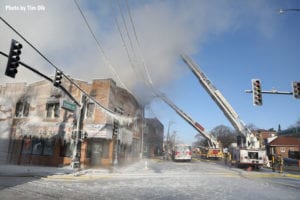By David Cain
Scenario: The forecast calls for heavy snow of two or more feet followed by subzero temperatures of -10°F to -15°F. The snow has started falling, and the wind is blowing at 20 miles per hour. No one is on the street at 0200 hours. This past week’s storm has dumped two feet of snow and ice. Road conditions are horrible. Ice, cold, and wind have the landscape looking like the Arctic. Then, the alarm sounds. The call for a structure fire at 124 Main street has engines rolling. Are you ready to deal with this and have you prepared for the extreme weather conditions?
Firefighting is a challenge, but when extreme weather conditions are present, the game is different. Cold weather is just one example. Heavy wind, and rain, an unrelenting heat wave, and other extreme situations also mandate timely checks and maintenance.
Firefighters and their equipment must be prepared for this challenge. Being prepared starts with complete checks of vehicles and all associated equipment along with the station itself before the weather turns nasty. Then, there must be timely maintenance that ensures maximum performance and safety in the most difficult conditions.
Bulletproof checks and maintenance are important in the mildest and most cooperative weather. They become critical when cold and other inclement conditions place maximum stress on everything. As we learned with the Challenger Space Shuttle disaster, which occurred because the O-rings failed in cold weather, operations are only as strong as the weakest link.
Everything moves slower in extreme cold. Apparatus slows down from poor road conditions, firefighters move slower on snow pack and ice and when advancing lines, and hitting fire hydrants is tougher. Your size-up must consider snow loads on the roof, frozen or downed power lines, frozen hydrants, freezing water, and the creation of a skating surface.
Consider the following to make sure all they are part of your department’s standard operating procedures for winter operations:
- Initial attack, staging, and rehab.
- Fatigue and dehydration.
- Poor footing, slips, and falls.
- Turnover of crews.
- Salt and deicer.
- Gross decon in a freezing environment.
- How and where to rehab.
Strain and fatigue are obvious on a firefighter, but how do these cold weather condtions affect equipment? Hoselines will freeze if they do not remain flowing, and flowing water creates a slip-and-fall hazard. To prepare for this weather, take the following advanced actions that may not be necessary under normal weather conditions:
- Spray your caps and plugs with antifreeze. This will make it easier to remove in extreme cold.
- Consider that gasoline does not efficiently vaporize at -10°F or lower.
- Keep your engines running. Diesel fuel can also have problems in extreme cold. Make sure you have a way to refuel.
- Consider a “cold weather package.” Many departments will empty their water tank for fear of it freezing. Consider putting warm water into your tanks as the mass of this water will keep things moving.
- Hydraulic lines, steering components, turrets, and drive trains can freeze. Consider other synthetic fluids during these times. Check with your emergency vehicle technicians and truck manufacturers.
This winter has been very tough for many areas of the country. The polar vortex was a hard reminder of what can happen in many places. As firefighters, these conditions are very hard on our equipment as well as us physically. Knowing when these conditions are coming is the start of preparations. Always brief your firefighters as a reminder of how and why we need to get ready for the cold. There is a mind shift in how we operate. We must also make sure our equipment is ready for this shift as well. Be prepared!
I clearly remember one of my first cold weather fires. That night, it was -15°F, and the structure was a large three-story office building. My adrenaline was keeping me warm as we approached the structure. As it turned out, there was no one inside, but the fire was in the ceiling space and was very difficult to extinguish.
We fought hard to stop the spread, but the fire got the best of us, so we had to back out and take a defensive stand. What I clearly remember is, once the master streams were set, the whole scene turned into an ice arena. It was so cold that the water coming from the tower was turning into ice pellets before it hit the ground. This was going to be an all-nighter.
Sand was ordered, fuel was needed, and crews were getting cold, so we summoned a bus to the scene for rehab. Once inside—where it was warm—I remember getting tired and very sleepy. Back then, we did not have a second set of gear, so after one more cup of coffee, it was back outside. The building was lost, and the scene looked like something out of a science fiction movie. The whole scene was encased in ice. Hoselines were frozen solid and turned into rigid pipes. Flatbed trucks were brought in to load the hose. Frozen large-diameter hose is not easy to move. Luckily, no one was hurt, but the equipment took a beating.
Within a week of that fire, the temperatures were in the 50s—not that uncommon in Colorado. However, the cold was not done with us. In the following days, we ran hundreds of calls for broken pipes and basements filled with water. The cold snap occurred during the university’s winter break. Many buildings and structures were vacant. I assumed that the heat was turned down or, in some cases, off. The water damage to all these structures was because of extreme cold.
Be prepared and train with your firefighters for these extreme conditions. Make sure your equipment and your apparatus are ready. In summary, consider the following: Snow load, downed power lines, ice and freezing water, poor visibility, rehab, dehydration, exposure, sheltering, emergency operations center, salt and deicer, frostbite, evacuation and sheltering of the displaced, cold weather package for your pumpers. And finally, do not wash your apparatus during these cold streaks—for obvious reasons!
Author’s note: I want to thank the University Fire Department at the University of Alaska—Fairbanks, Vail (CO) Fire and Emergency Services, Boulder (CO) Fire-Rescue, and the Loveland (CO) Fire Rescue Authority for their help in providing some very valuable insight into winter operations.
David Cain is an operations chief (Ret.) with Boulder (CO) Fire-Rescue, where he served for 34 years. He now serves as a senior advisor for pstrax.com, a software platform that helps fire departments streamline and automate their apparatus, equipment, and narcotics programs. Cain can be reached at [email protected].
Photo courtesy of Tim Olk.


